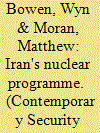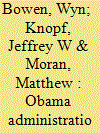|
|
|
Sort Order |
|
|
|
Items / Page
|
|
|
|
|
|
|
| Srl | Item |
| 1 |
ID:
129668


|
|
|
|
|
| Publication |
2014.
|
| Summary/Abstract |
This article examines Iranian proliferation behaviour through the lens of nuclear hedging. Defined as 'nuclear latency with intent', hedging is an area of proliferation behaviour that has not been fully explored. The Iranian case presents an outstanding example of the questions and types of evidence required to judge whether a nuclear programme is engaged in a hedging strategy. By examining a nuclear programme from three distinct angles - technical, narrative and diplomatic - key elements of strategic hedging can be identified. Applied to Iran, evidence supports a diagnosis of hedging. But this assessment is further complicated by Iran's domestic political context, which has engendered an approach that is as much 'hedging by default' as it is 'hedging by design'. This approach allows Tehran to reconcile restraint with domestic consensus on nuclear advancement. In this regard, our analysis shows that international exposure of Iran's undeclared nuclear activities had an enormous impact on the direction of Iran's nuclear programme, placing important constraints on Iran's nuclear progress. The article argues that any solution to the Iranian nuclear challenge must be based on realistic goals. The international community should focus on containing Iranian advancements rather than rollback, with a view to restricting hedging to a low level of latency.
|
|
|
|
|
|
|
|
|
|
|
|
|
|
|
|
| 2 |
ID:
140265


|
|
|
|
|
| Summary/Abstract |
For the past decade, much attention has been devoted to the potential consequences of a nuclear-armed Iran. Yet the binary ‘acquisition/restraint’ lens through which the Iranian nuclear issue is frequently viewed is limiting. There is now much evidence to suggest that Iran is engaged in a strategy based on nuclear hedging, rather than an outright pursuit of the bomb. This does not change the need to contain Tehran's proliferation potential, yet it does add another layer of complexity to the challenge. Iran will retain a low level of latency whatever the final outcome of longstanding diplomatic efforts to constrain the scope and pace of its nuclear efforts. This article will explore the implications of Iranian nuclear hedging and consider how regional rivals might interpret and respond to Tehran's nuclear strategy. On a larger scale, the article will explore the potential impact of the international community's approach to the Iranian case—implicitly recognizing, even giving legitimacy to, hedging—both in terms of the future of the Nuclear Non-Proliferation Treaty (NPT) and the ability of the international community to limit the negative effects of this form of proliferation behaviour.
|
|
|
|
|
|
|
|
|
|
|
|
|
|
|
|
| 3 |
ID:
177064


|
|
|
|
|
| Summary/Abstract |
This article examines responses to the Syrian government’s possession and eventual use of chemical weapons (CW) in that country’s civil war from 2012 to 2013. During this time, the United States and other outside powers applied coercive strategies, in both deterrent and compellent modes. Outcomes varied: compellence in the form of coercive diplomacy achieved a partial success, getting Syria to give up much of its chemical stockpile, but there were multiple deterrence failures, culminating in a large-scale sarin gas attack in August 2013. We examine this record to draw lessons about factors associated with the effectiveness of coercion. Our analysis draws on insights from existing research on both deterrence and coercive diplomacy to develop an integrated analytical framework involving the interplay of three factors: credibility, motivations, and assurance. We find the typical default approach to coercion, based on demonstrating toughness and threatening to impose costs using airpower—an approach we call the “resolve plus bombs” formula—was not sufficient to change Syria’s calculations regarding chemical use.
|
|
|
|
|
|
|
|
|
|
|
|
|
|
|
|
| 4 |
ID:
135703


|
|
|
|
|
| Summary/Abstract |
As relations between the US and Russia grow more tense, uncertainty is increasing over the future of bilateral agreements limiting nuclear arsenals. Wyn Bowen examines the prospect for US – Russia arms control in light of alleged treaty violations.
|
|
|
|
|
|
|
|
|
|
|
|
|
|
|
|
|
|
|
|
|